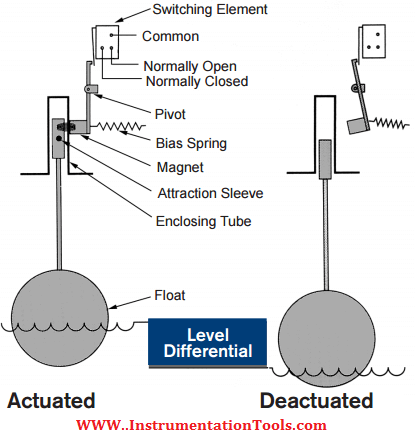Float Operated Level Switches
Principle:
All float operated liquid level controls operate on the basic buoyancy principle which states “the buoyancy force action on an object is equal to the mass of liquid displaced by the object.” As a result, floats ride on the liquid surface partially submerged and move the same distance the liquid level moves. Because of this, they are normally used for narrow level differential applications such as high level alarm or low level alarm.

Working:
The float rides on the process liquid surface, precisely tracking liquid surface motion.
Rising liquid level lifts the float, sliding the attraction sleeve up inside the enclosing tube and into the magnetic field to actuate the electrical or pneumatic switch (signaling liquid presence).
Subsequently, falling liquid level lowers the float, drawing the attraction sleeve out of the magnetic field to deactuate the electrical or pneumatic switch (signaling liquid absence). Float-type level switches are generally able to handle high-temperature applications, and sometimes prove useful for close interface detection.
Floats can operate up to three switching elements. Independent switching levels may be obtained with tandem floats. Consult the vendor for special float switching arrangements. All these are optional & depends on our application.
Applications
Level alarms and controls in power plants, petrochemical plants and refineries, chemical plants, paper mills, sugar mills, ships etc (Wherever liquid flows in and out of tanks/pressure vessels/sumps)
Also Read: Differential Pressure Switch Working Principle